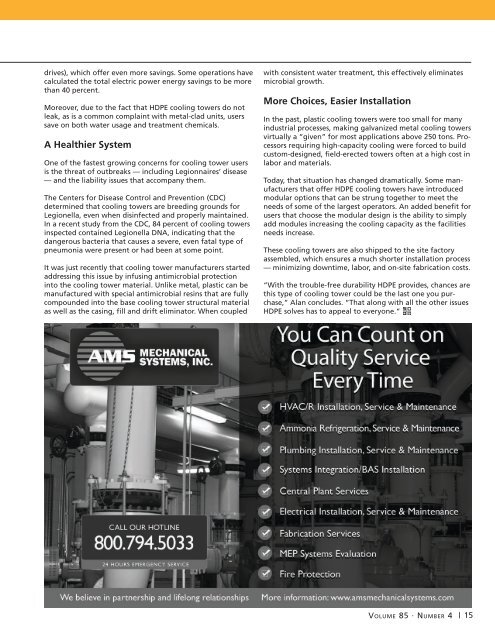CEAC-2020-04-April
You also want an ePaper? Increase the reach of your titles
YUMPU automatically turns print PDFs into web optimized ePapers that Google loves.
drives), which offer even more savings. Some operations have<br />
calculated the total electric power energy savings to be more<br />
than 40 percent.<br />
Moreover, due to the fact that HDPE cooling towers do not<br />
leak, as is a common complaint with metal-clad units, users<br />
save on both water usage and treatment chemicals.<br />
A Healthier System<br />
One of the fastest growing concerns for cooling tower users<br />
is the threat of outbreaks — including Legionnaires’ disease<br />
— and the liability issues that accompany them.<br />
The Centers for Disease Control and Prevention (CDC)<br />
determined that cooling towers are breeding grounds for<br />
Legionella, even when disinfected and properly maintained.<br />
In a recent study from the CDC, 84 percent of cooling towers<br />
inspected contained Legionella DNA, indicating that the<br />
dangerous bacteria that causes a severe, even fatal type of<br />
pneumonia were present or had been at some point.<br />
It was just recently that cooling tower manufacturers started<br />
addressing this issue by infusing antimicrobial protection<br />
into the cooling tower material. Unlike metal, plastic can be<br />
manufactured with special antimicrobial resins that are fully<br />
compounded into the base cooling tower structural material<br />
as well as the casing, fill and drift eliminator. When coupled<br />
with consistent water treatment, this effectively eliminates<br />
microbial growth.<br />
More Choices, Easier Installation<br />
In the past, plastic cooling towers were too small for many<br />
industrial processes, making galvanized metal cooling towers<br />
virtually a “given” for most applications above 250 tons. Processors<br />
requiring high-capacity cooling were forced to build<br />
custom-designed, field-erected towers often at a high cost in<br />
labor and materials.<br />
Today, that situation has changed dramatically. Some manufacturers<br />
that offer HDPE cooling towers have introduced<br />
modular options that can be strung together to meet the<br />
needs of some of the largest operators. An added benefit for<br />
users that choose the modular design is the ability to simply<br />
add modules increasing the cooling capacity as the facilities<br />
needs increase.<br />
These cooling towers are also shipped to the site factory<br />
assembled, which ensures a much shorter installation process<br />
— minimizing downtime, labor, and on-site fabrication costs.<br />
“With the trouble-free durability HDPE provides, chances are<br />
this type of cooling tower could be the last one you purchase,”<br />
Alan concludes. “That along with all the other issues<br />
HDPE solves has to appeal to everyone.”<br />
Volume 85 · Number 4 | 15


















